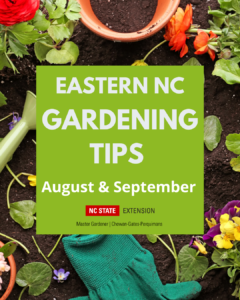August & September Gardening Tips
go.ncsu.edu/readext?1087939
en Español / em Português
El inglés es el idioma de control de esta página. En la medida en que haya algún conflicto entre la traducción al inglés y la traducción, el inglés prevalece.
Al hacer clic en el enlace de traducción se activa un servicio de traducción gratuito para convertir la página al español. Al igual que con cualquier traducción por Internet, la conversión no es sensible al contexto y puede que no traduzca el texto en su significado original. NC State Extension no garantiza la exactitud del texto traducido. Por favor, tenga en cuenta que algunas aplicaciones y/o servicios pueden no funcionar como se espera cuando se traducen.
Português
Inglês é o idioma de controle desta página. Na medida que haja algum conflito entre o texto original em Inglês e a tradução, o Inglês prevalece.
Ao clicar no link de tradução, um serviço gratuito de tradução será ativado para converter a página para o Português. Como em qualquer tradução pela internet, a conversão não é sensivel ao contexto e pode não ocorrer a tradução para o significado orginal. O serviço de Extensão da Carolina do Norte (NC State Extension) não garante a exatidão do texto traduzido. Por favor, observe que algumas funções ou serviços podem não funcionar como esperado após a tradução.
English
English is the controlling language of this page. To the extent there is any conflict between the English text and the translation, English controls.
Clicking on the translation link activates a free translation service to convert the page to Spanish. As with any Internet translation, the conversion is not context-sensitive and may not translate the text to its original meaning. NC State Extension does not guarantee the accuracy of the translated text. Please note that some applications and/or services may not function as expected when translated.
Collapse ▲Fall into Late Summer and Early Autumn–Gardening tips : August/September

Written by Extension Master Gardener Volunteer, Annette Thompson
August
This is a great time to obtain and send a soil sample to start getting ready for next spring’s planting and fertilizing. Material for soil samples, with instructions, can be obtained from county extension offices.
Begin now planning and planting cool season vegetables.
]August is a good time to evaluate the garden and make plans for next year. What plants did well? What needs dividing? What plants would you like to incorporate? What insects or pests were a problem?
As blooms fade on summer perennials, gardeners must decided to deadhead or not to deadhead….Deadheading is removing spent flowers from a plant to make it tidier, promote continued bloom production, or prevent fruit and seed production. Choosing not to deadhead is an option if gardeners want to save the seeds that will be produced for the birds to benefit from in winter. Here is a link to an article from Penn State Extension on deadheading.
Summer flowering bulbs can be divided, replanted, and/or shared as their leaves begin to turn brown and die. If the bulbs don’t need dividing, wait to trim back the foliage to about 2-3 inches until it begins to yellow.
Begin clearing out any annuals that have finished blooming.
Continue to water plants as needed, avoiding overhead watering to prevent disease. Water from the plant base or use soaker hoses — a good way to water since soaker hoses don’t wet the foliage or disturb the soil structure. Watering is best done early in the day.
September
Early fall is a great time to plant for spring, as well as for cool season vegetables.
Check garden centers for spring flowering bulbs that can be started now. When choosing bulbs, bigger is better. Also make sure the bulbs are firm.
If your garden needs a little color, do some fall planting of mums, asters, pansies and other fall bloomers. The NC State Plant Toolbox site, is an excellent resource to help find plants that fit individual gardening needs.
Fertilize and lime lawns as indicated on soil sample results.
Be on the lookout for insects and diseases as they can proliferate in the fall. Use pesticides sparingly and always follow label instructions—“the label is the law” for safe pesticide use.
Prepare houseplants that have summered outside for re-entry – be especially vigilant for insects and treat accordingly before bringing unwanted guests into the house.



